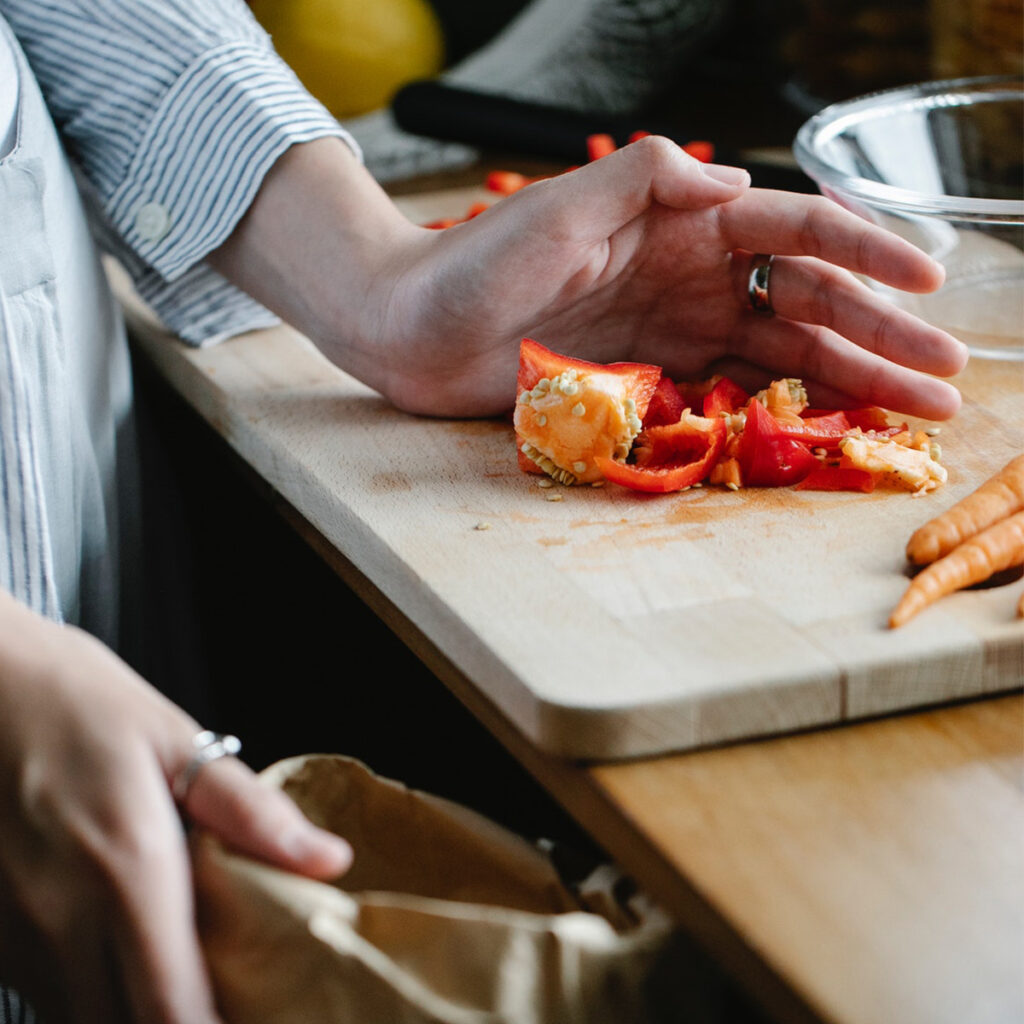How to reduce food waste at home? It contributes to greenhouse gas emissions, wastes water and other resources it takes to grow the food. Use these tips to reduce food waste. Save money, get the most out of your food & help the environment!
Jump to:
- 1. Meal plan
- 2. Use a Grocery List
- 3. Freeze, preserve, or can surplus fruits and vegetables
- 4. Learn how to properly storage your food
- 5. Keep your fridge organized!
- 6. Save your Leftovers
- 7. Use everything
- 8. Think twice before throwing food away!
- 9. Put your food waste to use!
- 10. Make vegetable stock out of your veggie scraps
- 💬 Reviews

While the average consumer is not the greatest threat to the environment compared to large corporations, it is still crucial we take steps to reduce our environmental impact. Saving food in your home starts with a mindset change. It includes being intentional and mindful about your purchases, planning for meals, and preparing your food.
These tips to reduce food waste will not only have a strong individual impact on you and your lifestyle but will also help create a healthier and more sustainable future for us all!
1. Meal plan
This helps you buy only the groceries you need, so you're less likely to let food spoil. Plan and make the same meal more than once. Have a recipe linked to each item you buy and include quantities on your list! Don’t shop hungry - if you can.
2. Use a Grocery List
A list helps you avoid buying things you don't need, which reduces the chance that you'll waste food.
If you are a single or couple household, I very much recommend buying produce at your local farmers market. Shopping there not only supports the local farmers and economy, but you usually have full control over how much you buy. Pre-packed food at grocery stores is often too much for single households.
3. Freeze, preserve, or can surplus fruits and vegetables
These are a good ways to extend the life of foods that you might not be able to use right away.
Make the freezer your friend!
This is the easiest way to ensure your produce lasts. That way produce stays fresh longer, especially abundant seasonal produce.
One of the best ways to use frozen fruits and vegetables is in smoothies. Since they are already frozen, they will help get the perfect consistency for your drink. Make sure to label your container or bag with the date you froze its contents. Fruits generally last up to a year, and vegetables last about 18 months.
Have you ever tried to preserve your produce by pickling it?
Pickling fruits and vegetables can keep them safe and edible for years because it creates an inhospitable environment for bacteria. Potentially dangerous pathogens simply can’t survive the acidity of vinegar - incredibly cool right? Pickling is one of the simpler methods of food preservation, and comes with great health benefits too!
Other ways of preserving food, despite freezing and pickling, are canning, fermenting, oil packing, salting, and drying.
4. Learn how to properly storage your food
Proper storage (such as using airtight containers and keeping the fridge at the right temperature) can help extend the life of your food, so you don't have to throw it away as quickly.
Improper storage leads to a massive amount of food waste worldwide. Not every vegetable and fruit should be stored in the fridge. For example tomatoes, potatoes, garlic, and onions should be kept at room temperature. Storing specific fruit or vegetables next to each other can also influence their ripening process, so make sure you know how to properly store your food.

5. Keep your fridge organized!
There are many ways how to organize your fridge, for example the FIFO method. Try out different styles to see what works best for you.
Overall, containers and labels are your friends when it comes to fridge organization. I also recommend you get in the habit of a weekly clean-out session, best before you shop groceries. This gives you a perfect overview of what you still have, what may have turned bad, what you may eat asap, and additionally it helps keep your fridge clean. It is important to regularly clean your fridge, or at least give it a wipe down, because of the build-up of mold and spillage from various perishable items kept in the fridge. Hence, don't forget to wipe down the shelves and drawers once a week!
6. Save your Leftovers
Instead of throwing away food that's left over from a meal, find ways to use it up in other dishes.
Keep your leftovers and store them in a clear glass container in eyesight. That way you don't forget them, since they are very visible. Saves you money, time and makes a great lunch!
7. Use everything
Try to use as much of each food item as possible (such as using the stems of broccoli or the skins of potatoes) to reduce waste.
Eat the skin and stems (eg: broccoli stems, strawberry greens). These parts are often edible and have many nutrients!
8. Think twice before throwing food away!
Many people assume that the “best by” + “sell by” signs are expiration dates and throw out perfectly edible food. These dates help markets know when to rotate their stock! Products are often perfectly fine even after those dates, especially when never opened before.
The easiest way to identify if a food is turned bad is to trust your senses. If a product smells, looks, or tastes spoiled, it probably is. However, mold is a definite sign that something belongs in the garbage! Many greens and vegetables may slightly soften or wilt when they are just past ripe. They still may make excellent additions to soups, smoothies, or baked dishes!
9. Put your food waste to use!
Instead of throwing away your food scraps, compost them. This way you are giving nutrients back to the soil, reducing your carbon footprint, and conserving landfill space. Plus it's also great for starting your very own garden!
If you have extra food that you're not going to use, consider donating it to a local food bank or other organization.
10. Make vegetable stock out of your veggie scraps
Collect them in a freezer-friendly + reusable bag. Freeze until full/you have enough to cook the broth with it.





Comments
No Comments